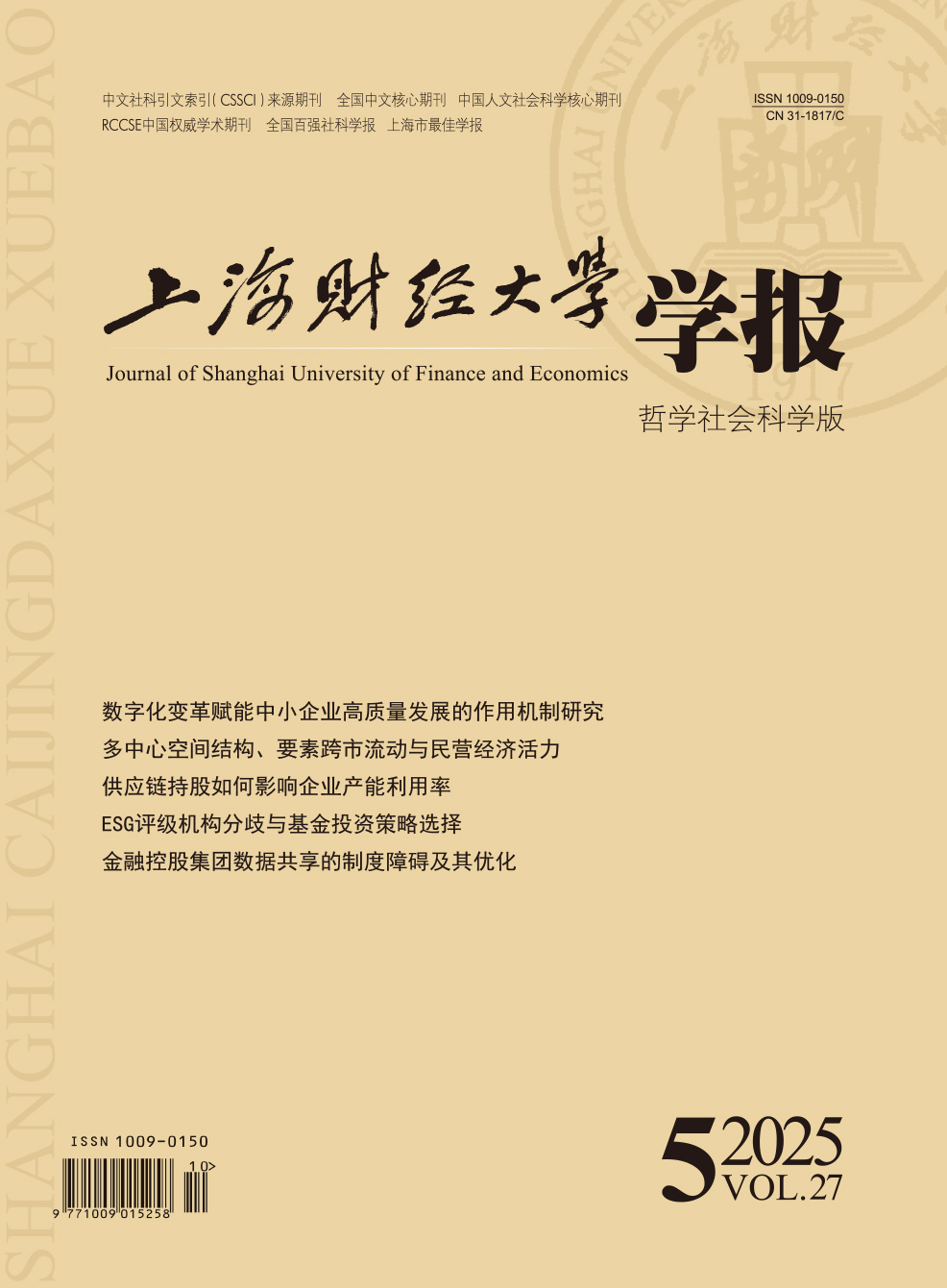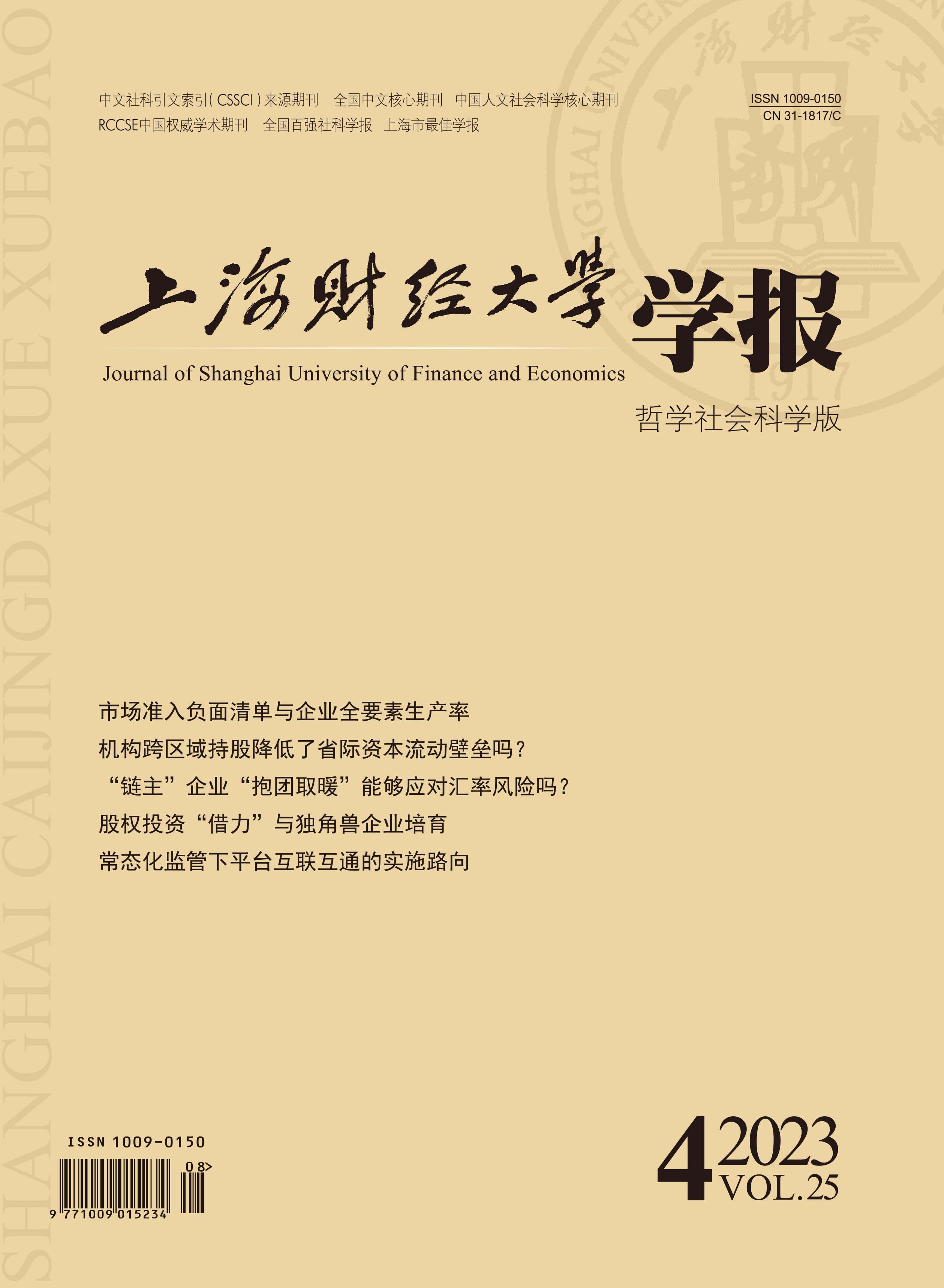全球价值链(GVC)中的“链主”企业主动选择先在国内嵌入产业集群,再以集群“抱团取暖”的形式嵌入国际循环GVC中,这种双循环新发展格局将对企业的出口汇率弹性产生影响。文章采用企业-产品-目标国-时间匹配数据,对“链主”企业延长国内价值链、缩短国外价值链的双循环新发展格局能否获得应对汇率风险的比较优势进行检验。研究结果显示,双循环新发展格局通过产业集群的横向集聚效应和纵向集聚效应对“链主”企业产生反馈效应,对“非链主”企业产生溢出效应,进而提高其应对汇率风险的能力;“链主”企业降低汇率风险的机制在于提高出口价格的汇率弹性,降低出口数量的汇率弹性,这一机制主要源于企业的高生产率、生产规模和上游位置;且出口企业距离“链主”企业越近,“链主”企业的溢出效应越强。这为促进国内价值链与国外价值链的良性互动的双循环新发展格局提供了理论支持和政策启示。
“链主”企业“抱团取暖”能够应对汇率风险吗?——基于双循环新发展格局的视角
摘要
参考文献
8 张建华. 大力构建中国主导的全球价值链[J]. 瞭望,2020,(38).
9 Ahn J, Khandelwal A, Wei S J. The role of intermediaries in facilitating trade[J]. Journal of International Economics,2011,84(1):73–85. DOI:10.1016/j.jinteco.2010.12.003
10 Alfaro L, Chor D, Antràs P, et al. Internalizing global value chains: A firm-level analysis[J]. Journal of Political Economy,2019,127(2):508–559. DOI:10.1086/700935
11 Antràs P, Chor D. Organizing the global value chain[J]. Econometrica,2013,81(6):2127–2204. DOI:10.3982/ECTA10813
12 Antràs P, Chor D, Fally T, et al. Measuring the upstreamness of production and trade flows[J]. American Economic Review,2012,102(3):412–416. DOI:10.1257/aer.102.3.412
13 Antràs P, de Alonso G. On the geography of global value chains[J]. Econometrica,2020,88(4):1553–1598. DOI:10.3982/ECTA15362
14 Autor D, Dorn D, Katz L F, et al. The fall of the labor share and the rise of superstar firms[J]. The Quarterly Journal of Economics,2020,135(2):645–709. DOI:10.1093/qje/qjaa004
15 Bas M, Causa O. Trade and product market policies in upstream sectors and productivity in downstream sectors: Firm-level evidence from China[J]. Journal of Comparative Economics,2013,41(3):843–862. DOI:10.1016/j.jce.2013.01.010
16 Berman N, Martin P, Mayer T. How do different exporters react to exchange rate changes?[J]. The Quarterly Journal of Economics,2012,127(1):437–492. DOI:10.1093/qje/qjr057
17 Costinot A, Vogel J. Matching and inequality in the world economy[J]. Journal of Political Economy,2010,118(4):747–786. DOI:10.1086/655858
18 Gaubert C, Itskhoki O. Granular comparative advantage[R]. NBER Working Papers 24807, 2018.
19 Hu C, Xu Z Y, Yashiro N. Agglomeration and productivity in China: Firm level evidence[J]. China Economic Review,2015,33:50–66. DOI:10.1016/j.chieco.2015.01.001
20 Koopman R, Wang Z, Wei S J. Estimating domestic content in exports when processing trade is pervasive[J]. Journal of Development Economics,2012,99(1):178–189. DOI:10.1016/j.jdeveco.2011.12.004
21 Levinsohn J, Petrin A. Estimating production functions using inputs to control for unobservables[J]. The Review of Economic Studies,2003,70(2):317–341. DOI:10.1111/1467-937X.00246
22 Li H B, Ma H, Xu Y. How do exchange rate movements affect Chinese exports?-A firm-level investigation[J]. Journal of International Economics,2015,97(1):148–161. DOI:10.1016/j.jinteco.2015.04.006
23 Pietrobelli C, Rabellotti R. Global value chains meet innovation systems: Are there learning opportunities for developing countries?[J]. World Development,2011,39(7):1261–1269. DOI:10.1016/j.worlddev.2010.05.013
24 Upward R, Wang Z, Zheng J H. Weighing China’s export basket: The domestic content and technology intensity of Chinese exports[J]. Journal of Comparative Economics,2013,41(2):527–543. DOI:10.1016/j.jce.2012.07.004
25 Wang Z, Wei S J, Yu X D, et al. Characterizing global value chains: Production length and upstreamness[R]. NBER Working Paper 23261, 2017a.
26 Wang Z, Wei S J, Yu X D, et al. Measures of participation in global value chains and global business cycles[R]. NBER Working Paper 23222, 2017b.
引用本文
宁密密. “链主”企业“抱团取暖”能够应对汇率风险吗?——基于双循环新发展格局的视角[J]. 上海财经大学学报, 2023, 25(4): 33-48.
导出参考文献,格式为:
上一篇:论企业数据交易的所得税法适用
下一篇:要素价格、产业转型与农民工回流





 6344
6344  5057
5057

